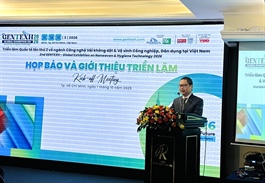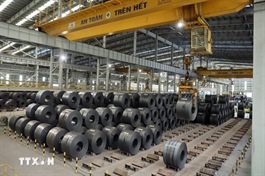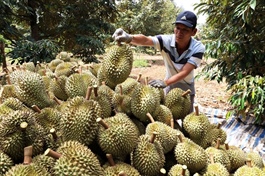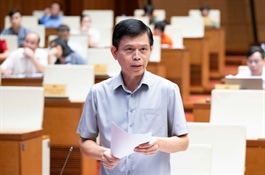Vietnam can exploit potential from carbon market
Vietnam can exploit potential from carbon market
With high forest cover and strong green carbon potential, Vietnam has the chance to expand in the global carbon market. Pham Hong Luong, deputy director of the Department of Forestry and Forest Protection under the Ministry of Agriculture and Environment, told VIR’s Hoang Oanh how selling forest carbon credits generates revenue and strengthens forestry’s role in green growth.

Pham Hong Luong, deputy director of the Department of Forestry and Forest Protection under the Ministry of Agriculture and Environment |
In August, the government approved the sale of one million forest carbon credits to the World Bank, earning about $5 million. How do you assess the significance of this deal for the economy and position of Vietnam’s forestry sector?
The sale cements the position and potential of Vietnam’s forestry sector in the green development process.
Economically, the $5 million represents a significant source of foreign currency for reinvestment in forest protection and development, especially in the context of Vietnam’s need for more resources for green growth and climate commitments. This transaction demonstrates that forests are not only a source of timber and non-timber forest products, but also create value through their ability to absorb and store carbon.
This is also a driving force to improve sustainable forest management, while providing opportunities to increase income and improve livelihoods for thousands of people who depend on forests.
The deal is seen as an international recognition of Vietnam’s efforts to reduce emissions under the REDD+ mechanism. The protected forest areas for credit issuance also contribute to maintaining biodiversity, conserving rare flora and fauna species, and raising public awareness of the important role of forests in responding to climate change.
Institutionally, the successful transaction is a testament to the gradual improvement of the legal framework for forest carbon credits in Vietnam. This is a valuable experience for further improving the capacity for measurement, reporting, verification (MRV) and negotiation, moving towards deeper participation in the global carbon market. Vietnam’s international reputation is also strengthened by affirming its capacity to implement commitments in the Paris Agreement.
Does the $5/tonne CO2 price in the World Bank deal accurately reflect the value of Vietnam’s forest carbon credits, and what should Vietnam do to increase the value in future deals?
The price that the World Bank pays, via the Forest Carbon Partnership Facility, is essentially a results-based payment mechanism. This is not a normal commercial transaction, but this agreement aims to support Vietnam in implementing its Nationally Determined Contribution (NDC) commitment and promoting sustainable forest governance.
Compared to the voluntary market, many high-quality forest credits, linked to community benefits and biodiversity conservation, are being purchased for $10-15, or even higher. However, in the agreement with the World Bank, Vietnam still has a huge advantage because all costs of project establishment, MRV, and recognition of emission reduction results are funded by the World Bank.
At the same time, after the sale, the World Bank agrees to let Vietnam retain up to 95 per cent of the emission reduction results to fulfill its NDC obligations, instead of buying outright and selling in instalments.
To increase the value of credits in upcoming transactions, Vietnam needs to focus on several directions. It needs to improve the quality of credits and ensure transparency, longevity, and community benefits; perfect the MRV system according to international standards; build a clear benefit-sharing mechanism for forest keepers; and approach international buyers who need high-quality credits, instead of relying only on large-volume contracts at low prices.
What is the potential of Vietnam’s forestry industry on a global scale?
Vietnam’s forestry sector has many advantages, of which the forest cover of more than 42 per cent is an important basis for creating a large amount of carbon credits. Currently, the country has just over 10 million hectares of natural forest, 4.7 million hectares of planted forest, and great potential from the mangrove ecosystem with outstanding carbon absorption capacity, opening up a huge space for the development of blue carbon.
Vietnam is also preparing to participate in the voluntary carbon market and towards fully operating the domestic carbon market after 2028, opening up opportunities for both domestic and foreign enterprises.
To realise its potential, Vietnam needs to continue to improve its legal framework, promote the application of technology in forest monitoring, and participate in global carbon market mechanisms. This is an opportunity for Vietnam’s forestry to develop sustainably.
In the context of increasingly vibrant carbon markets, what strategies will the Department of Forestry and Forest Protection prioritise to effectively develop forest carbon credits?
Currently, the department is advising the Ministry of Agriculture and Environment on negotiations for an emission reduction payment agreement for the Central Highlands and south-central region with the Alliance for Forest Finance Enhancement, with the expectation of exchanging and transferring about 5.15 million tonnes of CO2 at a unit price of no less than $10/tonne of CO2, and still retaining the emission reduction results and forest carbon credits to contribute to NDC.
If successfully negotiated, this will be the second emission reduction payment agreement in international transactions in Vietnam’s forestry sector.
With a view to expand scale, improve quality, and enhance transparency, Vietnam’s forest carbon credits promise to be more competitive, strongly attract international resources, and bring practical benefits to the forest protection community.
- 10:04 06/10/2025























